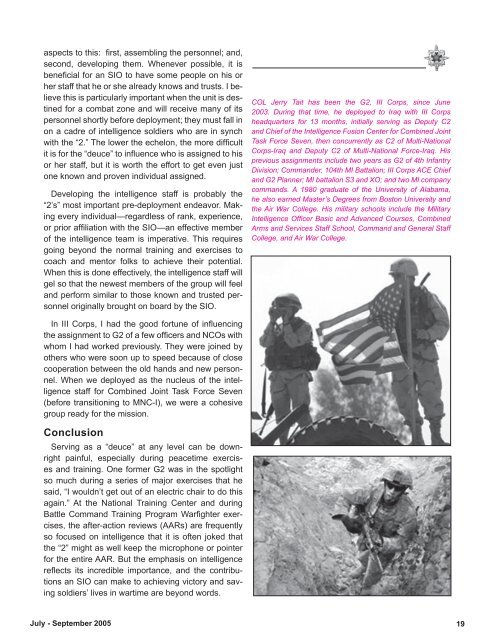Military Intelligence Professional Bulletin - Federation of American ...
Military Intelligence Professional Bulletin - Federation of American ...
Military Intelligence Professional Bulletin - Federation of American ...
You also want an ePaper? Increase the reach of your titles
YUMPU automatically turns print PDFs into web optimized ePapers that Google loves.
aspects to this: first, assembling the personnel; and,<br />
second, developing them. Whenever possible, it is<br />
beneficial for an SIO to have some people on his or<br />
her staff that he or she already knows and trusts. I believe<br />
this is particularly important when the unit is destined<br />
for a combat zone and will receive many <strong>of</strong> its<br />
personnel shortly before deployment; they must fall in<br />
on a cadre <strong>of</strong> intelligence soldiers who are in synch<br />
with the “2.” The lower the echelon, the more difficult<br />
it is for the “deuce” to influence who is assigned to his<br />
or her staff, but it is worth the effort to get even just<br />
one known and proven individual assigned.<br />
Developing the intelligence staff is probably the<br />
“2’s” most important pre-deployment endeavor. Making<br />
every individual—regardless <strong>of</strong> rank, experience,<br />
or prior affiliation with the SIO—an effective member<br />
<strong>of</strong> the intelligence team is imperative. This requires<br />
going beyond the normal training and exercises to<br />
coach and mentor folks to achieve their potential.<br />
When this is done effectively, the intelligence staff will<br />
gel so that the newest members <strong>of</strong> the group will feel<br />
and perform similar to those known and trusted personnel<br />
originally brought on board by the SIO.<br />
In III Corps, I had the good fortune <strong>of</strong> influencing<br />
the assignment to G2 <strong>of</strong> a few <strong>of</strong>ficers and NCOs with<br />
whom I had worked previously. They were joined by<br />
others who were soon up to speed because <strong>of</strong> close<br />
cooperation between the old hands and new personnel.<br />
When we deployed as the nucleus <strong>of</strong> the intelligence<br />
staff for Combined Joint Task Force Seven<br />
(before transitioning to MNC-I), we were a cohesive<br />
group ready for the mission.<br />
Conclusion<br />
Serving as a “deuce” at any level can be downright<br />
painful, especially during peacetime exercises<br />
and training. One former G2 was in the spotlight<br />
so much during a series <strong>of</strong> major exercises that he<br />
said, “I wouldn’t get out <strong>of</strong> an electric chair to do this<br />
again.” At the National Training Center and during<br />
Battle Command Training Program Warfighter exercises,<br />
the after-action reviews (AARs) are frequently<br />
so focused on intelligence that it is <strong>of</strong>ten joked that<br />
the “2” might as well keep the microphone or pointer<br />
for the entire AAR. But the emphasis on intelligence<br />
reflects its incredible importance, and the contributions<br />
an SIO can make to achieving victory and saving<br />
soldiers’ lives in wartime are beyond words.<br />
COL Jerry Tait has been the G2, III Corps, since June<br />
2003. During that time, he deployed to Iraq with III Corps<br />
headquarters for 13 months, initially serving as Deputy C2<br />
and Chief <strong>of</strong> the <strong>Intelligence</strong> Fusion Center for Combined Joint<br />
Task Force Seven, then concurrently as C2 <strong>of</strong> Multi-National<br />
Corps-Iraq and Deputy C2 <strong>of</strong> Multi-National Force-Iraq. His<br />
previous assignments include two years as G2 <strong>of</strong> 4th Infantry<br />
Division; Commander, 104th MI Battalion; III Corps ACE Chief<br />
and G2 Planner; MI battalion S3 and XO; and two MI company<br />
commands. A 1980 graduate <strong>of</strong> the University <strong>of</strong> Alabama,<br />
he also earned Master’s Degrees from Boston University and<br />
the Air War College. His military schools include the <strong>Military</strong><br />
<strong>Intelligence</strong> Officer Basic and Advanced Courses, Combined<br />
Arms and Services Staff School, Command and General Staff<br />
College, and Air War College.<br />
July - September 2005 19
















